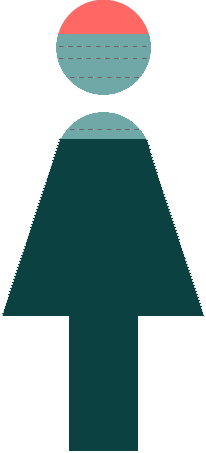
Why address pay equity?
Existing and upcoming regulatory requirements demand organizations to report pay gaps, external and internal stakeholders expect fairness and pay transparency and a diverse workforce depends on unbiased decision-making.
Comply with Regulatory Requirements
As of 2024, all organizations covered by the Corporate Sustainability Reporting Directive (CSRD)1) will be required to align their ESG reporting to the European Sustainability Reporting Standards (ESRS). At the same time, the EU has concluded its Pay Transparency Directive (PTD) which affects any employer with over 100 employees in a member state. Both ESRS and PTD demand reporting the average gender pay gap and its break-down into categories of workers. Employers with gaps over 5% will have to take remedial action. Similar jurisdiction in other countries such as US, UK or Australia. EqualPayMetrics applies complex statistics in an audit-proof way enabling organizations to comply with regulations.
Boost Organization Reputation
Externally, investors and customers increasingly demand organizations to report, and address pay equity results. Internally, employees and representatives seek transparency regarding pay equity. EqualPayMetrics addresses pay equity in an easy to understand and transparent way establishing a credible image as fair employer. This leads to better investor relations and customer satisfaction and creates a higher motivation in existing staff and stronger attraction when hiring.
Increase Diversity
Today, it is known that diverse organizations and teams operate more successfully. However, organizations struggle when measuring diversity in the workforce and effectiveness of activities to increase it. EqualPayMetrics enables organizations to continuously measure, control, and improve key levers of a diverse workforce such as unbiased promotions, fair performance evaluations and pay equity.
Terminology
The Unadjusted Gender Pay Gap is defined as the difference in pay between men and women. Statistic control of compensation-relevant differences results in the Adjusted Gender Pay Gap. Pay Equity is defined as discrimination-free pay. Thus, equal pay by no means contradicts common approaches to performance-related pay. While pay gaps are mostly reported on gender, other factors such as ethnicity, sexual orientation or religion may also be accounted for.
The Unadjusted Gender Pay Gap is the difference in average gross earnings between women and men across an entire population. According to the World Economic Forum, gaps vary greatly across countries (e.g., Iceland: 9.2%, Germany: 19.6%, US: 23.1%, Japan: 35.0%).
On average, women in Healthcare sector earn 30% less than men.
Attributing this gap to compensation-relevant differences (e.g., position level, tenure, performance etc.) between men and women results in the Adjusted Gender Pay Gap.

Adjusting for the fact that a higher share of men are doctors while women are nurses shrinks the gap to 10%.
Pay Equity is defined as elimination of all discrimination on the grounds of, e.g., gender, ethnicity, … with regards to all aspects and conditions of remuneration for the same work. Thus, equal pay by no means contradicts common approaches to performance-related pay.



A 0% difference between men and women for the same work is Pay Equity.
Methodology
EqualPayMetrics applies industry-standard statistical methods to calculate adjusted pay gaps. We copied EuroStat methodology to fully comply with European Sustainability Reporting Standards (ESRS) and the EU Pay Transparency Directive (PTD).
Kitagawa-Blinder-Oaxaca decomposition
Kitagawa-Blinder-Oaxaca decomposition was used as state-of-the art statistical method to explain the difference in the salary means between men and women by decomposing the gap into that part that is due to differences in the mean values of compensation-relevant variables, on the one hand (composition), and group differences in the effects of these variables, on the other hand (structural).
Factoring out composition effects results in the adjusted pay gap representing the gap between women and men that still exists even when women and men are compared with the same (measured) characteristics.

Breaking-Down The Unadjusted Gap
A break-down of the unadjusted gap requires complex statistics that organizations struggle to perform independently. EqualPayMetrics uses state-of-the-art methodology and visualizes results in an easy-to-understand way.
EqualPayMetrics adjusts the raw pay gap to differences in comp-relevant variables between men and women. We focus on both the unadjusted and adjusted gap when closing gaps.

Establish Pay Equity with EqualPayMetrics
EqualPayMetrics offers organizations an easy-to-set-up process. Organizations can measure their unadjusted and adjusted pay gaps, receive suggestions to close potential gaps and are able to control gap changes over time. The entire process is performed digitally and securely in the EqualPayMetrics-owned Equal Pay Calculator.
Prepare
Screen input data through Equal Pay Calculator
Assign factors to be controlled for in statistical model
Measure
Interpret results in easy-to-use Equal Pay Calculator
Identify main levers for improvement
Fix
Define input parameters (e.g., available budget) to reduce gap and manage salary increase of individual pay outliers
Review organizational processes of main gap drivers (e.g., hiring, contract negotiations)
Control
Utilize saved settings for easy re-screening of input data to control gap periodically
Assess effectiveness of measures and get comfortable with potential publications
Our Journey to EqualPayMetrics
EqualPayMetrics builds on the experience of successful pay equity controlling in a major DAX organization for the past years. Considering the upcoming ESRS/PTC, we want to enable other organizations to comply with these regulations and become an employer vouching for Pay Equity. We have developed a Equal Pay Calculator and are looking for customers to engage in a pilot at discounted price.
Pay Equity in Major DAX
Successfully measured and controlled unadjusted and adjusted gender pay gap in major DAX organization
Equal Pay Calculator
We have developed a Equal Pay Calculator enabling customers to screen their data, measure gaps and work towards Pay Equity in a few clicks
Roll-out
After successful pilot, roll-out solution to other organizations

From ESRS/PTD to EqualPayMetrics
With upcoming ESRS/PTD regulations demanding most organizations in EU to report on gender pay gap, we founded EqualPayMetrics to enable organizations to comply with ESRS/PTD and ensure Pay Equity
Pilot Phase
We offer organizations a pilot at discounted price to test EqualPayMetrics and the Equal Pay Calculator.
EqualPayMetrics...
Facilitates pay equity across the entire organization
Aligns with varying regulatory requirements such as ESRS, PTD, UK GPG Reporting, California Pay Data Reporting, ….
Is audit-proof through transparent methodology
Offers ways to close gaps while keeping a pay for performance philosophy
Applies consistent methodology across different entities - One report for entire organization
Controls gap changes through period assessments
No data leaves customer network
Impressum
Susanne Holocher
Römerstraße 213
53117 Bonn
info@equal-pay-calculator.com